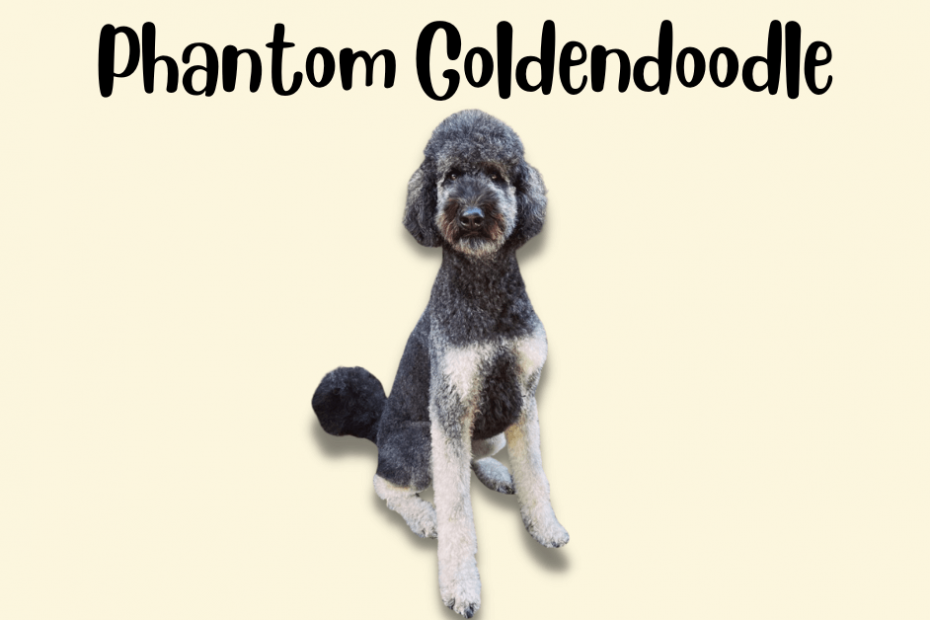Phantom Goldendoodles have nothing to do with Halloween costumes. Or the Phantom of the Opera for that matter.
Phantom is a unique pattern of two colors that is seen in some Goldendoodles. The Phantom coat is distinguished by a primary coat color, such as black, with accents of a secondary color (like white) on different regions like the legs and face.
So the designation Phantom Goldendoodle refers to a Goldendoodle having this coat pattern. In this article, I will take a deep dive into the genetics behind why some dogs will get this pattern while others don’t.
I will also cover the different phantom color sets along with other Goldendoodle colors, Phantom Goldendooodle breeders, and more!
What is a Phantom Goldendoodle?
Phantom is a color, and Goldendoodle is a dog breed. Therefore, the Phantom Goldendoodle is a distinctive and unique marking for Goldendoodles.
What does Phantom coloring mean? This means a dog with phantom coloring only has two different colors.
For a dog to be considered a Phantom Goldendoodle, there are clear rules that state the dog to have a primary color that covers most of its body parts and the second color appears on the dog’s eyes, muzzle, nose, and lower part of the legs.

This pattern is sometimes referred to as the dobie marking since it is similar to the pattern on Dobermans.
Generally, Phantoms are usually black and tan, although a mixture of red, black, and silver are also seen occasionally. Unsurprisingly, no two Phantom Goldendoodles are alike.
How does a Goldendoodle get Phantom coloring?
The Goldendoodle is a breed of a Golden Retriever and a Poodle. Therefore, the Phantom Goldendoodle is a type of Goldendoodle that comes in different color combinations, with its primary color being either black, red, chocolate, or silver.
The coloring and patterns of the Goldendoodle are mainly affected by inheriting genes from both parents. The Golden Retriever’s parent genes bring only shades of cream, apricot, and red to the Goldendoodle breed [1]www.akc.org/dog-breeds/golden-retriever.
These colors are dictated by the same gene, with the strength of the inherited gene determining the shade of color.
On the other hand, the parent, the Poodle, has many colors and patterns. The Poodle comes in striking colors, including black, apricot, cream, and white. The Poodle’s genes are to blame for the Phantom coloring seen in Goldendoodles.
Dog Coat Genetics
Dogs’ coat colors, patterns, textures, and lengths vary greatly. All of these characteristics are impacted mainly by genes acquired from parents. Therefore, a dog’s coat color is influenced by genes inherited from parent dogs to puppies and how the inherited genes are expressed in each dog.
Dogs’ genomes include close to 19,000 genes. But, only a few of them affect the physical variances in their coats. The dog’s mother and father pass down the genes in pairs [2]en.wikipedia.org/wiki/Dog_coat_genetics.
Patterns in dog’s coats are determined by pigments. There are two main pigments:
- Eumelanin – black, or taupe pigment
- Phaeomelanin – tan pigment that comes in red, gold, and cream colors.
- No pigment – whiteness due to a lack of melanin
At least two known alleles in dog genes account for the variance in coat color found in dogs. Each gene has a specific place within the dog genome known as a locus.
Regarding this topic, the loci associated with canine coat color for the pigment shade of the Golden Retriever, the parent dog for the Goldendoodle, is the I (intensity) locus [3]en.wikipedia.org/wiki/Dog_coat_genetics.
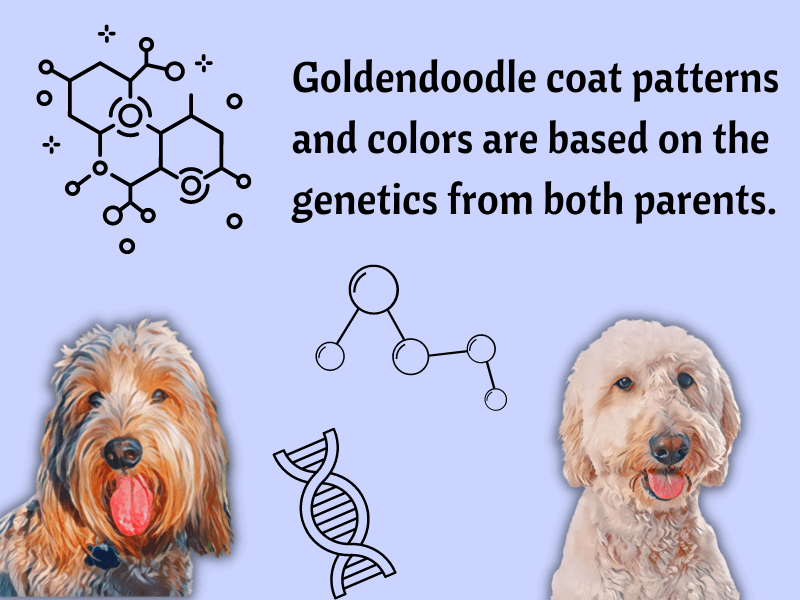
Pheomelanin dilution (changing a dog’s coat from tan to cream or white) was discovered to be the outcome of a mutation in MFSD12 in 2019, and it develops in varieties that do not have dark gold or red phenotypes.
Parti Color
There are many more variables concerning the coat color and markings of a Poodle. Some are recognized by the American Kennel Club (AKC) but only partially allowed for specific events [4]www.akc.org/dog-breeds/poodle-standard.
A parti Poodle is distinguished from Phantom Poodles by having a white base coat that is more than 50% white and a second color. The secondary color might show up anywhere on the dog. This is one of the qualities that set parti Poodles apart.
There are no two similar, and many breeders compare having a litter of partis to opening presents on Christmas [5]www.allpoodleinfo.com/parti-poodles.
The Poodle’s color may change as it matures. In terms of breeding, coupling two parti will always produce a litter of partis, but the color combinations and landing regions of color cannot be anticipated. A litter may have a black and white parti and apricot and white parti, with the colors falling in separate places.
Just like the parti coloring in Poodle, Phantom coloring has unique patterns in terms of color. The Phantom and parti-colored Poodles both have coats that display two colors.
Phantom Poodles, on the other hand, have a distinct pattern imprinted on their solid-colored coats, whereas the parti Poodle coat is at least more than half of its body white in color.
A Phantom Poodle also has a single-colored coat with bits of a second color emerging in a specific location.
Parti Goldendoodle
A Goldendoodles can inherit the parti-coloring from the Poodle parent. A parti Goldendoodle has a base coat color of white that covers more than half of its body. The remaining portion of its body would be a second color such as black, brown, red, etc.
What are the different colors that a Phantom Goldendoodle can be?
The colors of Phantom Goldendoodles can vary. This breed comes in different color combinations. The primary colors of the Phantom Goldendoodle include typical:
- black and apricot
- black and red
- black and cream
- black and silver
- black and grey
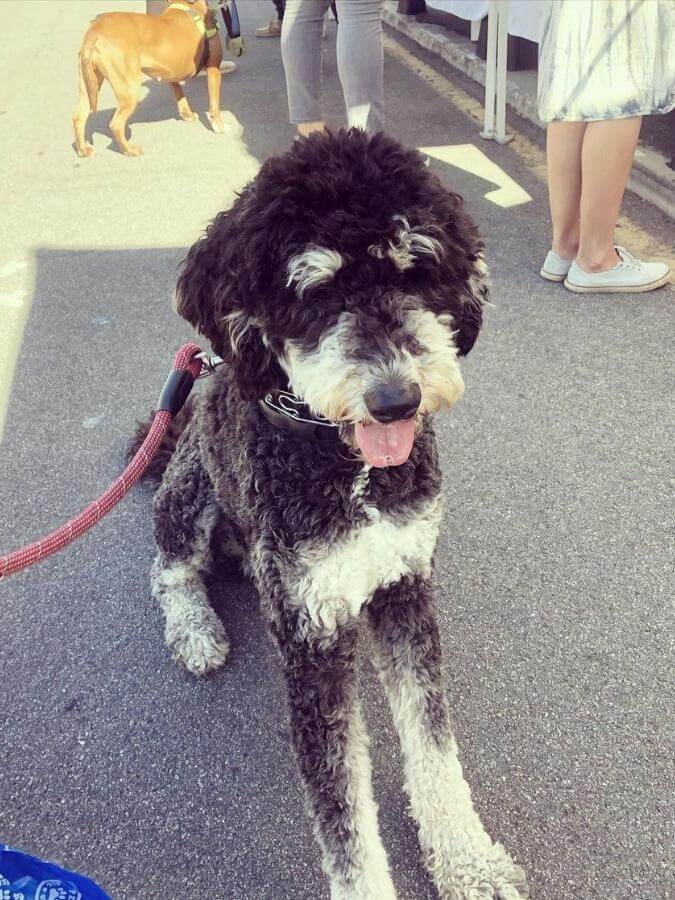
The color isn’t what distinguishes a Phantom from a Phantom. It’s where the secondary color marks appear. The marks must appear on specific areas of the dogs’ coats:
- on the sides of the muzzle
- down the legs
- under the tail
- above each eye
- on the ears
Phantom Goldendoodle is a very rare coloring of Goldendoodle. Phantoms are so rare that we cannot predict when we will have more or how often we will have them.
Phantom Goldendoodles have similar patterns to Tuxedo Goldendoodles. The main difference is that the tuxedo-pattern is distinguished with a white patch on the dog’s chest.
What types of Phantom Goldendoodles are there?
There are different types of Phantom Goldendoodles whose appearance is greatly influenced by their coloring. Since Phantom is not a color, it’s occasionally recognized as a pattern marking.
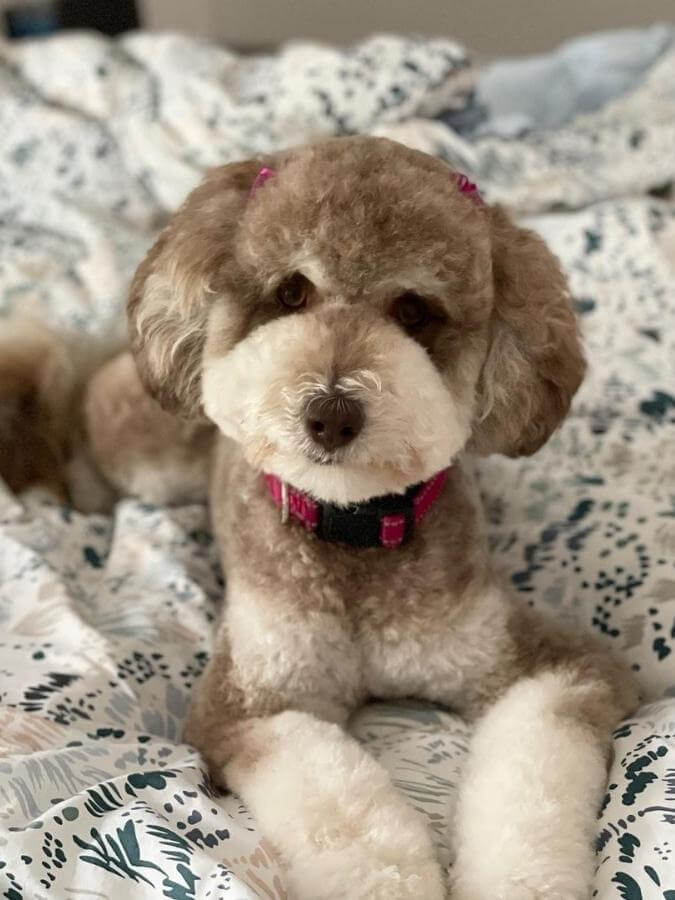
This means the Goldendoodle can come in various color combinations yet still be considered a Phantom.
The common types of the Phantom Goldendoodles include black phantom, silver phantom, red phantom, chocolate phantom, and sable phantom.
Black Phantom Goldendoodle
By far, this is the most common type of Phantom Goldendoodle. This type of Goldendoodle comes with a black coat color with a secondary color of either red, cream, gray, silver, apricot, or brown.

Silver Phantom Goldendoodle
The two coat colors are usually silver and cream. This means that the dog’s primary color coat pattern is silver. The main color is generally paired with the secondary color of cream.

Red Phantom Goldendoodle
With this type, the main color coat is red for Phantom markings. The red Phantom Goldendoodle is tough to come across. However, it’s usually paired with apricot, cream, or white as the secondary color.
Chocolate Phantom Goldendoodle
The chocolate Phantom Goldendoodle has a chocolate or dark brown coat as its primary color. Like the red Phantom Goldendoodles, chocolate Phantom Goldendoodles have a secondary color that is often apricot, cream, or white.

Sable Phantom Goldendoodle
This type has a coat with black-tipped hair and roots of any solid color. The black tips can appear anywhere on the coat.
Sable Phantoms will often look different as adults than they do as puppies. Their fading gene makes their coat lighten to an almost solid color as they age.
Usually, their puppy coat is solid black or has markings like a Phantom Goldendoodle. However, as they age, their coat will change rapidly to a white, gray, or light cream color. They are also referred to as tan phantoms.
What other colors can Goldendoodles be?
Goldendoodles come in different colors than just gold. Common Goldendoodle colors include: black, red, apricot, cream, and white. They can also have patterns such as merle, brindle, phantom, sable, and parti.
Red Merle Goldendoodles
The Goldendoodle can have a red merle color. This color is primarily influenced by the inherited genes from the Poodle’s parent dog. Merle is the result of a genetic mutation.
Merle Goldendoodles have genes related to those that cause albinism.
They can have pink noses and blue eyes. Goldendoodle merles may be found in various color patterns, including silver and red merles.
Blue Merle Goldendoodles
Another color is the blue merle. The blue merle Goldendoodle is a breed resulting from a Golden Retriever and a Poodle, or in some instances; it’s a cross breed of a black dog with merle patterning. Blue or partly blue eyes are common in these puppies.
Black Goldendoodles
Black Goldendoodles are relatively rare. However, having a black Goldendoodle is more likely if they are mixed in the second generation or third generation.
When a black Goldendoodle parent crosses with a black Poodle, the kids almost invariably have black fur. This suggests that the Poodle’s have the more dominant genes when it comes to effect on its color.
Apricot Goldendoodles
Apricot is another color of the Goldendoodles. The coat color will, however, change as the puppies grow old. Puppies from a red parent will typically be red or apricot.
This means the color will lighten after the puppies reach ten weeks. Apricot and red are similar. However, red Goldendoodles are much darker, while apricot Goldendoodles have a lighter color.
The Goldendoodle’s cream color is the consequence of crossing a Poodle with a Golden Retriever with the red dilute gene. The red gene gets diluted to produce a light yellow or dark cream color, similar to how red Labradors turn yellow.
Blue Goldendoodles
Blue Goldendoodles are rare to come by. This color is always difficult to identify. It will have a tone that is similar to silver or grey but with a hue that reflects blue.
This unique color is inherited from the Poodle. Many people are surprised that there are blue Poodles in existence (and Goldendoodles!).
A few honorable mentions
I’ve noted a few of the common colors and patterns a Goldendoodle may have. There are a few more to mention just to make sure we cover them all!
- White Goldendoodles
- Cream Goldendoodles
- Sable Goldendoodles
- Brown Goldendoodles
- Silver Goldendoodles
- Tan Goldendoodles
- Gray Goldendoodles
Where can you find Phantom Goldendoodles?
There are several reputable breeders across the U.S where you can find the perfect Phantom Goldendoodle of your choice. While Phantom Goldendoodle is rare, you should be careful to look for only genuine breeders.

Here is a list of a few breeders based on region that sell Phantom Goldendoodles:
West
Midwest
Northeast
South
How much does a Phantom Goldendoodle cost?
Different breeders charge differently for the Phantom Goldendoodle. The price of a Phantom Goldendoodle is greatly influenced by several factors, including size, color, and generation. These considerations can help you determine how much you should budget for your future Goldendoodle.
Goldendoodles come in five sizes: standard, medium, mini, toy, and teacup. Because these sizes do not have “official” standards, what one breeder terms a “toy” may be referred to as a “teacup” by another.
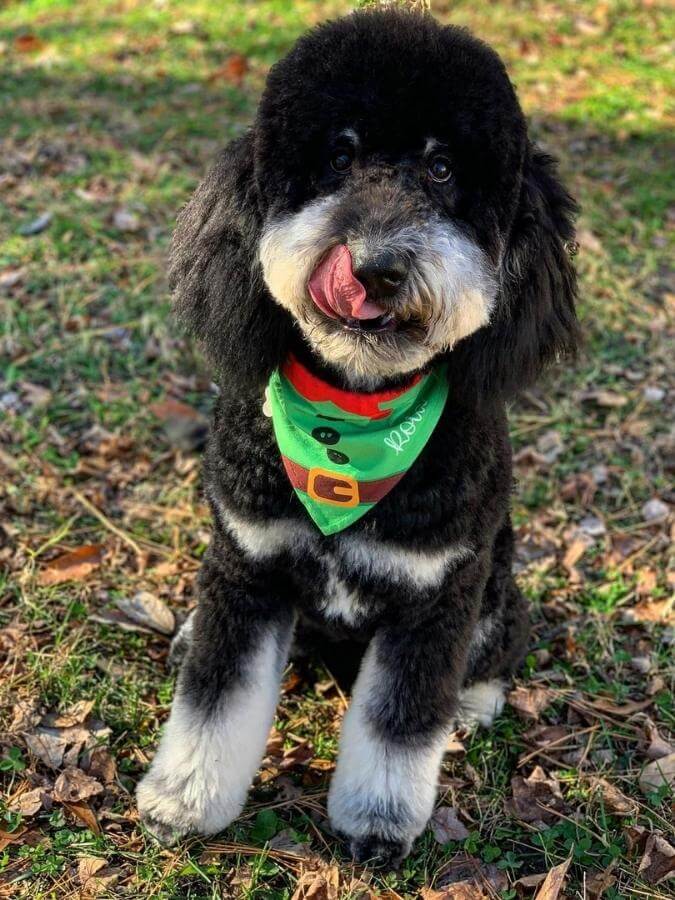
How does size affect the price of a Goldendoodle?
The smaller the size of the Goldendoodle, the greater the cost. For example, a toy or miniature Goldendoodle might cost $1000 more than a conventional Goldendoodle from the same breeder.
A teacup or miniature Goldendoodle may cost well over $2000. Platinum Goldies, for example, sells the tiny Goldendoodle F1 for around $2200.
The F1b generation, micro mini Goldendoodle, costs roughly $2800. This Phantom Goldendoodle has an approximate weight of 15 – 20 pounds. On the other hand, the standard F1 Goldendoodle costs about $800.
Does pattern or color affect price?
The price of the Phantom Goldendoodle from other dog breeds can be attributed to its color. Since Phantom means only two colors, these Goldendoodles have unique color and multi-color patterns, like parti, merle, Phantom, and sable.
Most Goldendoodle breeders base their price in part on coat color or pattern. This means that Phantom Goldendoodles with rare or desirable patterns will be significantly more expensive than their solid-color counterparts.
Tuxedo Goldendoodles can often have a higher price than a solid-colored Goldendoodle. Also, rare colors such as parti, sable, and merle are more costly than gold or white.
If you seek a specific color pattern or combination, expect to see a big increase in price per Goldendoodle puppy!
Final Thoughts
Phantom is a rare pattern found in the Goldendoodle dog breed. It consists of two colors – the primary color covering almost its entire body and the secondary color, such as a silver color, appears in smaller regions such as the eye.
Key Takeaways
- The Phantom Goldendoodle is a mix of a Poodle and a Golden Retriever.
- The Goldendoodle inherits genes from its parents that influence its coloring and markings. This remarkable component makes the Goldendoodle unique from other breeds.
- There are a few different Phantom Goldendoodle types: silver phantom, black phantom, chocolate phantom, and sable phantom.
- You can get a Phantom Goldendoodle from reputable breeders all across the country.
- The price of a Phantom Goldendoodle is greatly dictated by various factors, including color, size, and generation. The more unique the colors and patterns, the higher price you will pay.
Main post image source: Kea the Phantom Goldendoodle


